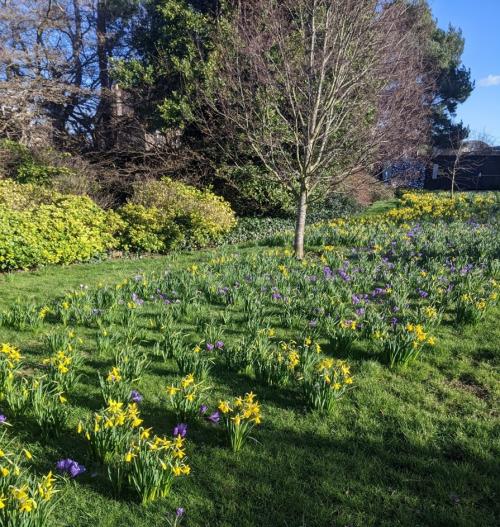Having visited the beautiful, serene landscapes of the Royal Botanic Garden, Edinburgh (RBGE) many times as a visitor, I jumped at the chance to see ‘behind the scenes’, meeting some of the researchers who are carving their path in plant science research. I have to confess that my PhD is not at all related to plants – I am studying zoonotic bacterial pathogens and antibiotic resistance in wildlife and livestock at a neighbouring SEFARI partner, the Moredun Research Institute. However, the scientific work at RBGE includes genome projects, so I was keen to meet researchers that incorporate bioinformatics into such projects in a similar manner to my own work. Ultimately, I wanted to get a better understanding of how these highly transferable skills are being applied in different sectors of life science research. RBGE boasts several research departments covering topics such as Tropical Diversity, Major Floras, Cryptogamic Species (those that reproduce via spores) and Conservation Genetics - with such a diverse range of topics, I knew my visit would allow me to cross paths with some fantastic researchers.
Image: RBGE is home to beautiful scenery and flora, including the rare field elm (Ulmus minor ‘Umbraculifera Gracilis’) of which only four specimens are known.
I began my visit over coffee with Dr Flávia Fonseca Pezzini, the resident bioinformatician who collaborates with RBGE staff and students on a range of different projects and conducts her own research on the evolutionary history of the Neotropics. We had a really great chat about all things bioinformatics – particularly as we both use a high performace computing cluster, or HPCC, to aid in our genomic data analysis. A HPCC is a remote collection of computers, or nodes, which are particularly suited for use when a typical laptop or desktop won’t suffice. For my PhD, I am analysing DNA sequences from a Nanopore MinION sequencer – a technology that sequences very long reads of DNA. Availing of a HPCC makes the data handling more manageable, but it does require extensive training and familiarity with coding. I picked up some great tips and advice which I hope to be able to apply during my PhD.
We were later joined by Gustavo Ramos, a PhD student at RBGE who works on taxonomy and the genetic basis of flower symmetry in Amazonian tree species. After chatting a little bit more about coding, we finished our coffee and Gustavo kindly showed me around. He introduced me to some of the numerous PhD students based at RBGE. It was encouraging to see so many early career researchers present and it felt like a very supportive space to pursue a PhD.
Image: A snippet of the PhD community at RBGE, from left to right: Matt Rees, Karen Keegan (myself), Gustavo Ramos, Cynthia Fan, Charles Miller, Briggitthe Melchor Castro and Thibauld Michel.
After lunch I met with Dr Catherine Kidner who has a lab based within the Tropical Diversity department and seeks to understand large scale patterns of diversity in tropical plant species. Dr Kidner spoke to me about a current project on gene expression in Hillebrandia sandwicensis, which is found only in Hawaii and forms a sister lineage to Begonia, another plant genus studied in Dr Kidner’s lab. Dr Kidner also uses Nanopore sequencing in her research and I picked up some interesting tips and recommendations, particularly for assembling genomes of species using this sequencing technology. I was then given a whistle-stop tour of the lab facilities at RBGE, including the ‘NGS’ (next generation sequencing) lab, where samples undergo quality control and preparation for genomic sequencing.
Thanks to all at RBGE who took the time out of their day to chat to me and show me around the wonderful research institute. These exchanges are a great opportunity for early career researchers to network, expand their knowledge and explore career options. At RBGE it also leads to a great day out and a renewed appreciation for the wonder of plants!
Karen Keegan, 2nd year PhD student at the Moredun Research Institute. Contact details: karen.keegan@moredun.ac.uk. LinkedIn: www.linkedin.com/in/karen-keegan-342a68a2.
-------------------------------------------------------------------------------------------------
Chiara Boni, a 1st year PhD student, Rowett Institute (University of Aberdeen) was the first SEFARI PhD exchange student and you can read her experience in her blog which is available here.
